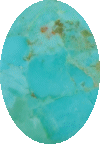| |
Turquoise
|
Turquoise is probably of French origin meaning "Turk's Stone", this is because most of the turquoise in early Europe came through Turkey. Turquoise owes its beautiful colors to its copper content and most turquoise today is primarily a byproduct of copper mining. It has a long history as a sacred stone and has been much sought after for ornamentation throughout human history.
Modern turquoise endures many treatments that may surprise people. The most common of which is called stabilization. This is where they take inferior grades of turquoise and impregnate them with polymers. Dye is sometimes added to enhance the color if the original material was considered too pale. These stabilized stones are employed in most of the Native American jewelry on the market today.
Reconstitution is an even more deceptive process by which they powder chalk turquoise and mix it with adhesive, gluing the bits together. Recently it has been found that cabochons of this type usually have very little if any true turquoise in them. This treatment is easier to detect because the color and the pattern of the stone is often more uniform than in natural turquoise. It can be tested for by applying a hot pin to the back of a cab, melting the resin compound.
The only process permitted on gem quality turquoise is polishing with paraffin wax, this is usually done to high quality or "agate hard" turquoise. It has been argued that the some of the following folklore only concerns true turquoise or stones that have not undergone any processing other than cutting and polishing with paraffin.
Turquoise was used as a horseman's talisman in the Near East. It was believed that by wearing a bit of turquoise, or attaching it to the bridle of the animal, then the horse and rider would be protected from a great many causalities and misfortunes such as snakebite, lameness, or the sickness caused from the horse drinking cold water when overheated. The stone was also imbued with the ability to protect the wearer from if thrown from a horse. In this case the turquoise was believed to absorb all of the impact and break instead of the wearer.
Later lapidaries extended this protection to cover all manner of falls. They also expanded the gems virtues to include the ability to cure melancholy, sooth the eyes, and to protect from the evil eye and other misfortune.
In Europe the turquoise was believed to grow pale when the wearer was sick or of poor character, and lose all color if the wearer died. Its color could then only be restored when worn by one of good health and disposition. Some accounts held that the turquoise would also fade when the wearer was in danger, and to return to its original luster once the peril had passed.
The turquoise was considered a lover’s stone in by French lapidaries. The folklore of the gem is unique in that turquoise has historically been a gift a woman gives to a man to initiate or encourage courtship, in the reverse of the majority of other courtship rituals that require the male to initiate with a gift. Turquoise jewelry was exchanged as a courtship token between lovers in the belief that the color of the stone would wax and wane with the intensity of the love they shared. The turquoise was the stone of choice in wedding rings for Russian couples for many centuries prior to Soviet Russia.
Turquoise was held sacred by many indigenous north American nations. Though the origin stories of the nature of this sacredness vary by nation, most involve themes of protection, virility, and spiritual power. Archers and marksman will attach the turquoise to their bow or gun to ensure that their aim was true. Travelers carried turquoise fetishes to protect themselves and their livestock from disease, misfortune, and evil spirits. And turquoise was often included in grave goods, especially in the southwest, where a belief endures that the deceased will be able to buy passage to the afterlife with the turquoise included in their burial.
This belief that the turquoise housed a beneficial spirit is interesting in that it appeared in many different cultures, both in the Old World and the Americas. Another reoccurring theme was the belief that in order to gain the full benefit of the spirit of the turquoise one had to have received the turquoise as a gift. And in order to maintain the benefit the wearer had to behave in a just and honorable way and be of good nature, least the stone fade with their character. To those that met both qualities, a piece of jewelry set with turquoise was said to be a most protective and lucky amulet indeed.
|
Colors
|
Shades of light blue or green.
|
Locations
|
Australia, Brazil, Burma, China, Egypt, Norway, Pakistan, and the USA
|
Compisition
|
CuAl6(PO4/OH2)4(H2O)
|
Hardness
|
6
|
|

|

|

|
|
|
|
|
|